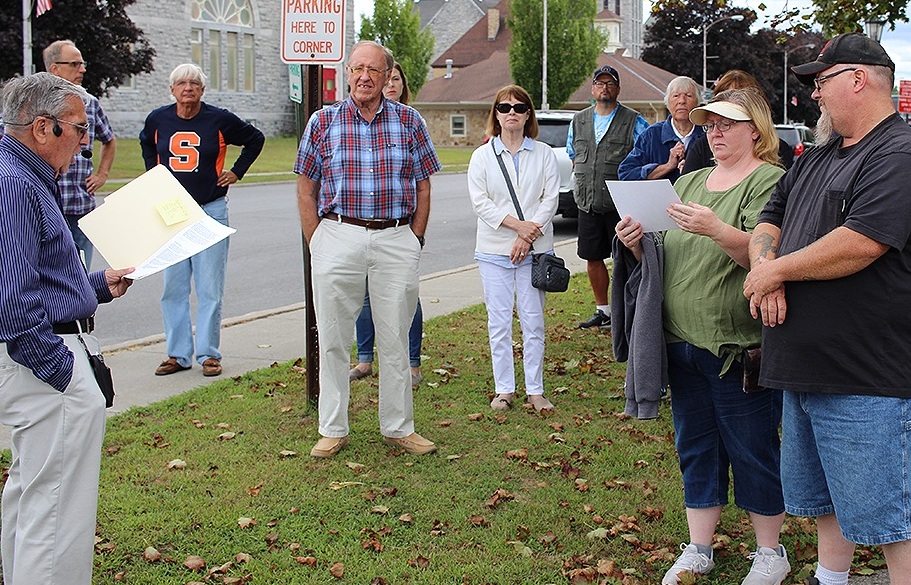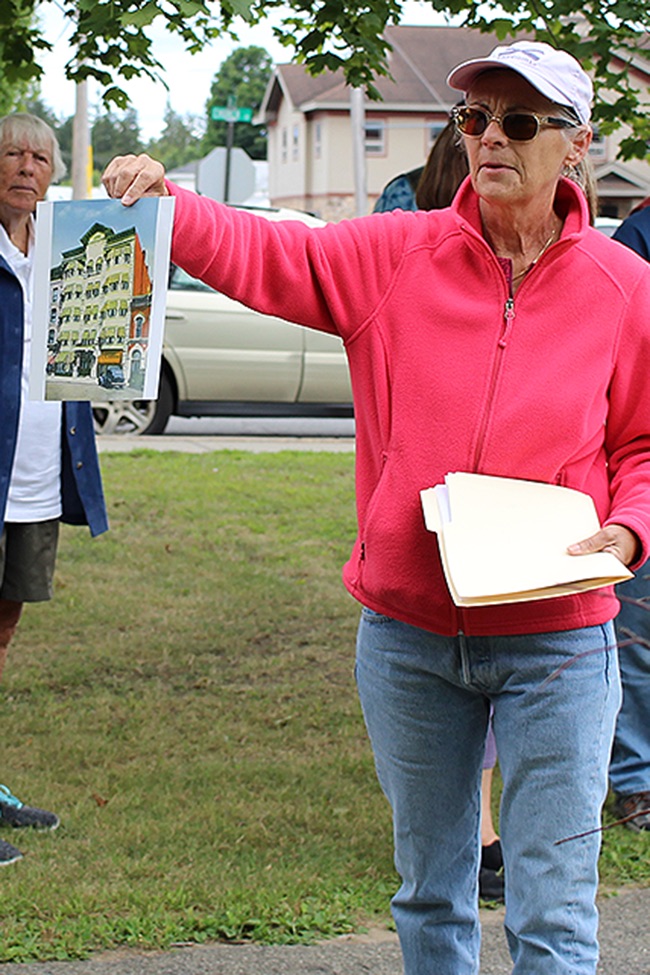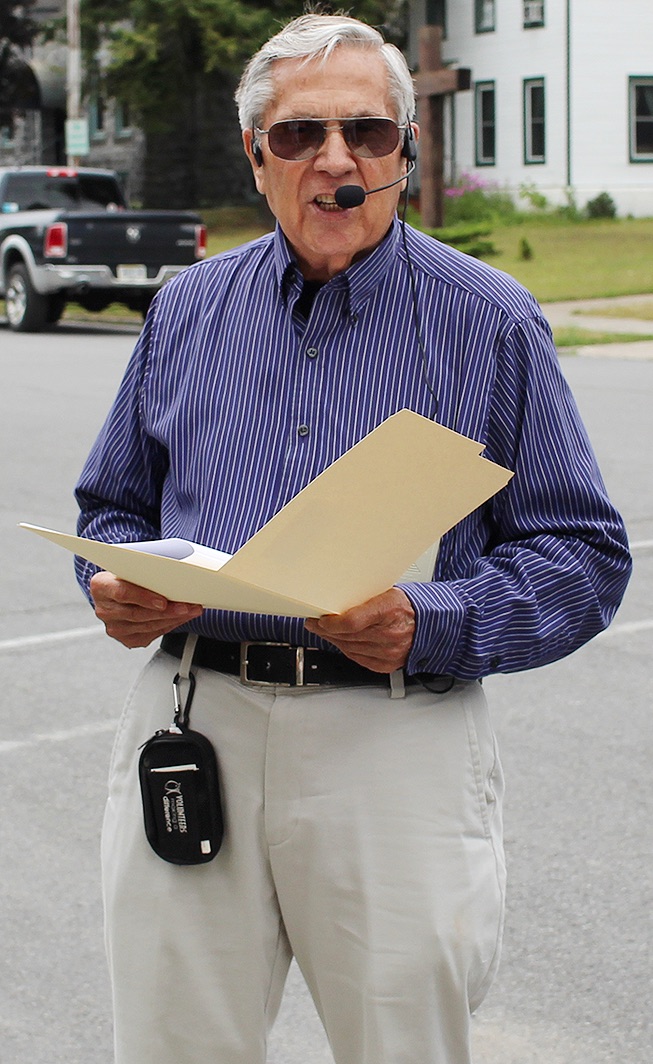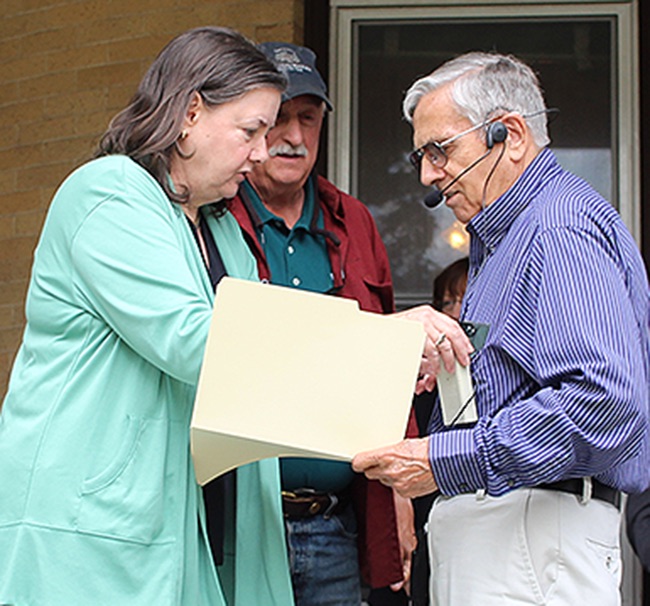by Rachel Hunter
Gouverneur’s history came alive on Saturday, August 24 as Town of Gouverneur and Village of Gouverneur Historian Joe Laurenza led a historic walking tour around Gouverneur.
Lance Rudiger of the St. Lawrence County Historical Association said it was just one of the several walking tours around the county that were presented by local historians, in partnership with the SLCHA.
A crowd of 20 interested local citizens first gathered at the Gouverneur Museum, and were greeted by the mouth-watering smell of the chicken barbecue. A total of 150 chicken halves were prepared by the Gouverneur and Edwards masons for the occasion.
Mr. Laurenza, who also serves as president of the Gouverneur Historical Association, started the historic walking tour at the Gouverneur Morris by saying the following: “Gouverneur, originally named Cambray, is named after Gouverneur Morris. He bought a total of 90,000 acres in three purchases. Cambray was first in the 1770s, and then the rest to Morristown, also named after him.
“Gouverneur Morris was a founding father, and a personal friend of George Washington. He held several government positions, and was minister to France. He was quite a ladies man and had many mistresses. He did not marry until his late 50s.
He never lived here, but traveled to the North Country at least twice. We have a copy of some of his diary trips here. The originals are in the Smithsonian. He had a stone house built in Natural Dam about three miles west of Gouverneur, where his land agents resided to oversee his property. The house is still there in disrepair. It was bought this past spring by a young man from Antwerp.”
Mr. Laurenza then showed the crowd a photo of the Gouverneur Morris house.
“Several books have been written about Gouverneur Morris,” Mr. Laurenza said. “One interesting fact is that he had a peg leg. There are two theories: He fell off a horse drawn carriage, or he jumped out of a window one night when a husband came home.
“He changed the name from Cambray to Gouverneur in honor of his mother, Sarah Gouverneur.
“Gouverneur was first settled in 1805 when the first seven families arrived. Dr. Richard Townsend was Morris’ first land agent who accompanied them from Warren County. Their names appear on the arch in the park.”
Mr. Laurenza then talked about the Gouverneur Museum as follows: “The Gouverneur Museum was originally the manse to the Presbyterian Church, built in 1904 with money donated by the Dean family. In 1974, the church decided to sell the manse and give the minister a living allowance. The Gouverneur Museum Board bought it, and it officially opened its doors on July 4, 1976 on the 200th anniversary of the U.S. The Museum is managed by a board of 11, and has about 30 volunteers. The main building has three floors of artifacts, and a one-room library/research room. Southwest Tech BOCES in Gouverneur built a building that is behind the museum. We also have the Gouverneur Annex at the fairgrounds. We also own a one-room schoolhouse that is 10 miles from the village.”
Village Park
“The Village Park was not a planned park, as is usually the case. It was just a wind-blown sand lot,” Mr. Laurenza said. “In 1834, Peter Van Buren, who owned one of the hotels on Main Street (across the street from the park), took it upon himself to plant saplings to preserve the area. He and local children drew water from the Oswegatchie River by ox team to water the saplings in the park. Nothing was done with the park for about 40 years. It was open to the public in 1873 by the village board. Elm trees were planted in 1873, but was all taken down in the 1950s and 1960s due to Dutch Elm disease. The park had several fountains over the years and at least two bandstands.”
Mr. Laurenza then gave the floor to Village of Gouverneur Mayor Ron McDougall to talk about the upcoming changes to the village park.
“We got a grant from Senator Ritchie last year, Mayor McDougall said. “Senator Ritchie was just here on Wednesday, July 31 during fair week, and we went through it together. Our engineers, Bernier, Carr and Associates, put together a plan. They are subject to change, some of the plans. The macadam is going to go, of course some of these flagpoles, and in particular, the Memorial Arch is in dire need of some work there as well. People think it is just going to be the gazebo. It is going to be more than just the gazebo. The macadam is definitely going to go…”
Much gratitude was extended to Mayor McDougall for his comments as the historical walking tour continued.
Fountain
“The Fountain was placed in the park in 1876 on the 100th anniversary of the U.S. Independence,” Mr. Laurenza said. “The village spearheaded raising the funds. Funds were raised by the sale of $1 subscriptions. It was supposed to be in the park by July 4 of 1876, but arrived late and installed several weeks later. By 1957 the fountain was in disrepair. The Village did not want to pay for the repairs, and took it out of the park and put it behind the village barn. Frank LaFalce from Richville heard about it, and asked the village if he could have it. They let him take it to his home in Richville and he got it working again in his side yard where it was until 2010. Frank died in 1996 and his wife, Mary Ellen, died in 2010. She had willed it back to the village and Dave Spilman, Jr. volunteered to set it back up and got it working again. Dave continues to oversee it and runs water from the museum several times a week.”
Memorial Arch
“In 1905, on the centennial of the first settlers arriving in Gouverneur, the Memorial Arch was constructed in memory of the first settlers and those who lost their lives in wars,” Mr. Laurenza said. “There are several plaques honoring those who served in our armed forces. “Lest We Forget” was engraved on the front, and “Our Nations Defenders” on the back. The eagle was added in 1906 and donated by the Dean family. The eagle was damaged in 1988 by kids and was rebuilt and dedicated in 1990.
“The marble is from one of the nine marble quarries in the village.
“The cost in 1905 was $1,830.10. Donations came from businesses, individuals, sale of the centennial history of Gouverneur, and school children. Today’s cost would be in excess of a quarter-million dollars.”
The Lifesaver
“The Lifesaver is in our park because of Edward John Noble,” Mr. Laurenza said. “Noble was born in Gouverneur in 1882. He graduated from Gouverneur High School and Yale. His second job in 1912 was an ad man from a company in New York City. He was sent to Cleveland, Ohio where Clarence Crane was making candies. One was round white peppermint candy with a hole in the center. Noble suggested that to Crane to market the candy as aa LifeSaver. Two Reasons: A child could not choke on it if swallowed because of the hole in the center… and the other possible reason was life preserves on private or commercial ships were big, round white flotation devices. The Titanic sank in 1912.
“Crane did not like the idea and suggested Noble buy that part of his candy business for $2,900. He and a friend came up with the $2,900 and he got the recipe and equipment and moved everything he needed back to New York City. He rented an apartment and hired six girls. He also came up with the foil to keep it fresher. Other flavors were added beginning in 1929.
“The business grew rapidly and he built a plant in Port Chester, NY in 1920. Outside the plant were several huge LifeSavers. When the Port Chester plant closed and the candy division went to Canada, near Montreal, the company was not going to move the LifeSavers. They offered Gouverneur this one because Noble started the successful business and was from Gouverneur. The Rotary Club paid to have it moved and erected in out park in 1987.
“Noble had several positions in FDR’s administration. In 1943, he purchased the Blue Radio Network, now the ABC Network. He was the only individual to own a national radio station.
“Noble loved and vacationed in the Thousand Islands. He purchased Bolt Castle from Bolt Family in the late 1920s when it went up for sale. The Edward John Noble Foundation owned it for 50 years before turning it over to the Thousand Island Bridge Authority.”
Presbyterian Church
“The First Presbyterian Church was built in 1820,” Mr. Laurenza said. “The present church is the fourth Presbyterian Church. It was built in 1892-1893 at a cost of $50,000 and was paid off in 1902. The parsonage, now the Museum, was built in 1904 with monies donated by the Dean family. In 1920, the beautiful pipe organ was donated by Jennie Dean.
“In 1968, Head Start began in the lower level of the church and is still there.
“In 2015, the Church and the Museum were added to the National Registry of Historic Places.
“There have been 23 ministers of the Presbyterian Church in its 202 years. William Skinner was the longest serving minister, 52 years.”
Baptist Church
“The Baptist Church was organized in 1811, but the first church was not built until 1822,” Mr. Laurenza said. “Services were held in people’s homes. The second church was built in 1850. This is the third church and was built in 1894 at a cost of $25,000. In 1976, there was a fire that gutted the interior and the back wall had to be replaced. There were over 40 Baptist ministers before Rev. LaVeck, in 1993, became the minister of Christian Life Fellowship which it is known as today. It appears the demise of the Baptist Church was the result of friction between the Liberals and Conservatives of the congregation. Today, the Christian Life Fellowship Church, besides being a church, is heavily involved in helping the needy. Rev. LaVeck started a food pantry several years ago that provides food for hundreds of families each month. The basement of the church has over 20 refrigerators and freezers and shelving that completely fills the basement. The aisles are barely wide enough for the workers and patrons. This is a wonderful ministry he has taken on.”
Gouverneur Library
“In 1886 a room behind the Reynolds Block, which was in about the middle of the first block on Main Street, was used as a library. The Women’s Christian Temperance Union donated $30 which was used to purchase furniture. The Library opened with a reception at which 40 books were donated by those attending along with several magazine subscription. Concerts and dinners were held to raise money to support the library. Before the end of 1886, more rooms were found in the St. Lawrence Block. The library had increased its volume of books to 300. Donations continued of money and books. It became a circulating library, tickets costing $1.50 a year or books were loaned at one-cent per day. There were several other moves before the present building was built in 1900. Judge James Smith and Newton Aldrich gave $8,500 towards the present building. In 1953, an addition was added to the back of the building made possible by Mr. and Mrs. James Papayanos, local business owners.
“The Gouverneur Reading Room today continues to be run by a board of 11 people. Finding sources are: School vote to tax area residents, Friends of the Library memberships, Arts In The Park Craft Fair, Town of Fowler, Town of Gouverneur, Village of Gouverneur, and letters sent out in the fall for donations.”
Gale Ferguson of Gouverneur told the crowd gathered that, when talking about the Gouverneur Library, it was important to recall the Gouverneur Library Loft Renovation Project that was undertaken over a decade ago, that was funded by great contributions from individuals, companies, civic groups, foundations, and state funding as well.
Post Office
“The present building of the Gouverneur Post Office was opened in 1917,” Mr. Laurenza said. “An officially designated Post Office did not appear on the Washington records until 1824. Prior to 1824, Dr. Richard Townsend, Gouverneur Morris’ land agent, had area resident take their mail to his office and pick up their mail there. Townsend maintained some sort of post service until the time the first official Post Office was established in 1824.
“Until 1904, people had to pick up their mail as rural free delivery did not start until 1904. Village delivery service started in 1906. I could find no record of what businesses probably served as Post Offices after Townsend left the area in 1817. For those of you like myself, old enough to have watched Westerns, we would see people picking up their mail in a general store or some other local store.”
The Wesleyan Seminary
“The Wesleyan Seminary has been long gone,” Mr. Laurenza said. He then sent a historic photograph around for the crowd to see. “It was where the Community Bank is today. It was built in 1840, and was a three-story structure with an attendance of about 140 students. It was operated by the Methodist Conference.
“The seminary began in 1827 as a Grammar School called Gouverneur Union Academy. In 1828, the academy was incorporated as Gouverneur High School. In 1836, the management of the school was transferred back to the Black River Conference of the Methodist-Episcopal Church. The building burned, and the photo I sent around was rebuilt in 1840 at a cost of $5,500. The name was changed to Gouverneur Wesleyan Seminary. By 1869, the building and facilities had become inadequate to their need and the seminary was relocated to the campus of the Antwerp Liberal Literary Institute.
“After the Conference pulled out, the town board voted to issue bonds for the benefit of the seminary and the New York Legislature approve this and operated for the next 13 years as a semi-private institution benefitted by State aid.
“In the early 1880s, the building became a Union Free School. A Union Free School District is a district resulting from a union of multiple common school districts. Union Free School Districts are governed by a board of education.”
St. Lawrence Inn
“The St. Lawrence Inn was built in 1894,” Mr. Laurenza said. “I wish I had been around to see it in its heyday. It was a beautiful building. It was the only five-story building in this village. It was sold in 1945 to the Watertown Mattress Company. Today, Patti Farley-Spilman owns that building and uses it for family storage. Her consignment store is next door.
“During its day, the St. Lawrence Inn was the place to stay in Gouverneur, even though there were other smaller and nice hotels. It was listed as a 50-room hotel with an elevator and was a leading hotel in Northern New York. As time went on, more rooms had private baths and telephones. However, even with its many owners and manager over its 50-year history, it was not much of a money maker and was frequently in debt.
“It had its own restaurant and had for many years at 5 p.m., someone from the restaurant would go out onto the sidewalk and ring a bell, like the early school bells. That was to tell anyone in earshot that dinner was being served.”
Kinney Drugs/Burt O. Kinney
“Burt Kinney was born in Gouverneur in 1873 and died here at age 83 in 1966,” Mr. Laurenza said. “The first Kinney Drug store was started across the street by Burt O. Kinney in 1903. The original drug store is part of several previous businesses. One of Kinney’s Pill Distribution Centers is located there now. Some of the corporate offices are still upstairs in the complex. There are over 112 Kinney Drugs stores most in New York and some in Vermont.
“Burt Kinney graduated from the Gouverneur Wesleyan Seminary. As a young man he worked in the Dewey and Perrin Drug Store. Mr. Dewey was very impressed with Kinney and paid for him to go to Albany College of Pharmacy. Kinney graduated in 1901. In 1902, he took possession of the drug business when Dewey retired from the business due to poor health. In 1903, he bought the drug store and changed its name to Kinney Drugs. It was slow going at first. The first day’s sales were $158, and his second day’s sales were $36. He worked hard to keep from going under. Patrons of the store were sure of a welcome, treated courteously and he willingly paid attention to their needs. It was never too much trouble for B.O. to search for a particular item for a customer. Customers loved him and employees enjoyed working for him.”
Talc Company
“The Loomis Talc Corporation building and later Supreme Court building is now in terrible condition and used as a home,” Mr. Lauremza said. “In 1928, Loomis Talc Corporation built their new corporate offices on East Main Street. The building is across from Stewarts on East Main Street. Loomis Talc was one of several talc companies in the area. It’s a two-story structure. At one time and maybe still, it was the only building in the United States made almost entirely of talc. Side walls are tile and stuccoed with a mixture of talc and cement. Interior woodwork has an undercoating of talc and oil, over which was used a paint with Loomis Talc as a base. The interior walls and ceilings are all of talc. The borders of the floors are talc and concrete. Loomite, which was a new product developed by the Loomis Company, was used in the foundation walls and in the construction of the approaches. The chimney is built entirely of crude talc as well as the retaining walls at the east and West sides of the property. Windowsills and coping are all constructed of talc and the walls of the basement are covered with a mixture of talc and water.”
International Lace Mill
“The International Lace Mill is on the west side of the village on Prospect Street, behind the houses on the left side of Prospect Street. Most of the houses were company houses at the time,” Mr. Laurenza said. “The mill was built in 1902 and 1903. It was a huge facility. 1903 saw the first production run of lace products. The lace mill required importation of skilled weavers, mostly from Pennsylvania, and their families came with them. It was the first major source of employment of women in this area.
“In 1900, the federal government imposed a 70 percent tariff on the importation of lace and lace products, most of which came from England. The purpose of the tariff was to encourage domestic lace making.
“Lesser Brothers of New York City were importers and sales agents for English lace. They decided to seek a domestic source to produce their own lace. They canvassed their customers for suggested sites for a mill location and Anson Potter of Gouverneur, a dry goods merchant, recommended Gouverneur.
“In 1902, a Lesser Brothers representative came to Gouverneur to see if there was enough interest and financial backing for this new industry. There was. Construction began in 1902 on a 80,000 square-foot building of one and two stories. The exterior is red brick and there are acres of hardwood floors.
“Fifteen looms were imported from England. Each weighed five tons and were composed of 30,000 parts. By 1905, there were 10 looms and over 250 employees, mostly women.
“The mill closed in 1944. In 1945, Rushton Paper Mills bought the mill. Rushton Paper was in Natural Dam…”
Photos were passed around to show all those in attendance.
Much gratitude was extended to Gouverneur Historian Joe Laurenza following the walking tour.




